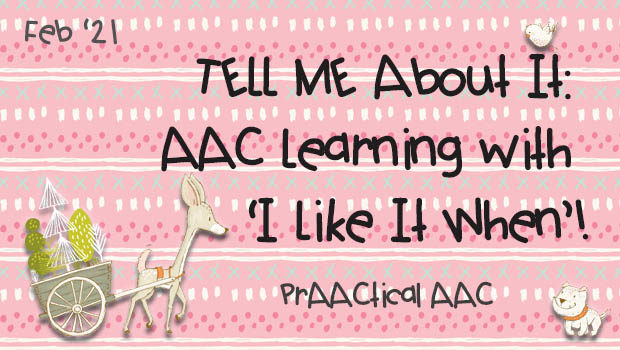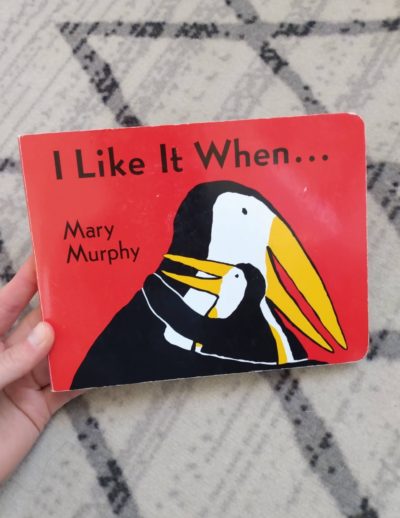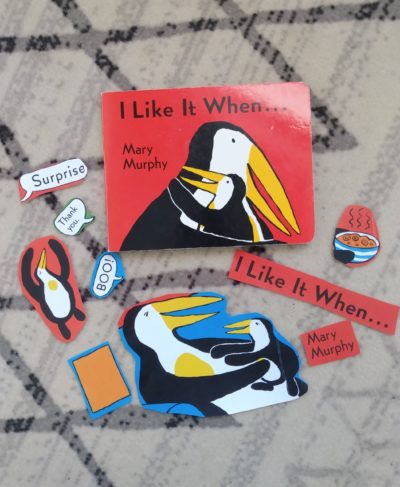TELL ME About It: AAC Learning with ‘I Like It When’!

 AAC SLPs Jeanna Antrim and Maggie Judson return to these pages for another guest post the TELL ME About It series. Today, they focus on the teaching opportunities in the book ‘I Like It When’! Maggie and Jeanna are speech-language pathologists who work in the Assistive Technology Department for the Belleville Area Special Services Cooperative (BASSC) in southern Illinois. They are AT/AAC facilitators and provide evaluations, direct therapy, consultations, and trainings with school teams. In this post, they share their ideas for classroom activities, e-learning, supporting AAC learning at home, and more.
AAC SLPs Jeanna Antrim and Maggie Judson return to these pages for another guest post the TELL ME About It series. Today, they focus on the teaching opportunities in the book ‘I Like It When’! Maggie and Jeanna are speech-language pathologists who work in the Assistive Technology Department for the Belleville Area Special Services Cooperative (BASSC) in southern Illinois. They are AT/AAC facilitators and provide evaluations, direct therapy, consultations, and trainings with school teams. In this post, they share their ideas for classroom activities, e-learning, supporting AAC learning at home, and more.
TELL ME About It: AAC Learning with ‘I Like It When’!
TELL ME About The Book
The sixth book in this new series is “I Like It When” by Mary Murphy. Such a fun book to use for shared reading, with its simple text, repeated lines, and engaging illustrations. Also, it’s chock full of embedded text (text that is part of the illustrations, such as speech bubbles), which is one of those print salient features we love to see in a book, as it provides us a context to point out and talk about the text (Zucker, T., et al, 2009). This book is excellent for connecting students’ home/school life to the characters’ activities (“I wonder if you like to splash when you take a bath?”) and for making fun comments like ‘Yay!’, ‘Uh-oh,’ or ‘Yum’! But most of all, we love this book for all the repetition of those oh-so-great core words! 
See below for the book focus for “I Like It When”:
Book Focus:
- Core Words (BOW WOW Words): LIKE, IT, GOOD
- Additional Words (Tiger Talk Words): play, read, sing, eat
- Concept Vocabulary: daily routine words
- Book Concept: Where to start reading
- Special Letters: j, q, a, m, t, p, o, n, c, d
TELL ME About Reading
Repeated Reading Focus: Words That Rhyme
Another way to change up your repeated readings is by focusing on words that rhyme in the book. This is a simple way to up your text referencing game, which helps draw students’ attention to the written word (hellllooo literacy!). To work this strategy into your shared reading instruction, point to the rhyming words, repeat them, and talk about how they sound the same at the end.
- “Look! Tight and night. Tight and night sound the same at the end. Tight and night are rhyming words!”
Adaptation Idea: Incorporate Removable Pictures
We have mentioned before how powerful story props can be to make a shared reading session super engaging. Another way to increase engagement is to create interactive story elements by attaching removable pictures in the book. We accomplish this by photocopying the story’s illustrations or buying a second copy of the book (especially when Scholastic has $1 book deals!). Then, we cut, laminate, and tape or velcro the pictures into the book, and voila! You have interactive story elements! Use them to increase engagement during the story, retell the story, or sequence the story’s events. And don’t forget the text! You can also do this for the title, author’s name, and any speech bubbles or embedded text, to draw attention to book concepts and written words. 
TELL ME About Writing
Writing is a big part of a TELL ME classroom! See below for ideas:
Predictable Chart Topic
Title: I LIKE IT!
Sentence frame: I LIKE IT when I _________.
FUNctional Writing Activity
For the month of February, could there be a more FUNctional writing activity than writing valentines to loved ones and friends!? Students can choose to make their own cards or fill in the TO and FROM blanks on store-bought valentines. This activity offers terrific opportunities for students to write their name and the names of peers, staff, and family.
TELL ME More
Below are some specific ideas on how to implement “I Like It When” in your therapy sessions and classrooms, TELL ME-style!
Aided Language Input Tip – Using the Word Finder Feature to Teach New Words
Providing aided language input is one of those instructional strategies you will find yourself doing over and over (and over!) again in a TELL ME classroom. When teaching new core vocabulary words, it can be beneficial to access the word in isolation (this decontextualized practice can assist with motor planning). You can do this with the word finder feature or search feature on most AAC apps/devices. Type in the word, tap on the sequence shown, and the system will automatically gray out everything except for the buttons required to access the target word. This provides an errorless method for saying the target word, plus bonus! It demonstrates how to find a word when we don’t know its location on the device. We love a good strategy that gives us a lot of bang for the buck!
Embedding Core into the Daily Routine – Music
Music time is typically a routine-based activity within the preschool classroom, making it a natural time to incorporate the target core words into different rote phrases. Having some predetermined scripts can support communication partners as they become comfortable with targeting core words and providing aided language input. Additionally, music is often a huge motivator for many of our students. Also awesome? Many songs that we sing in the preschool classroom are full of core words and offer lots of repetition!
Some examples:
- “After we READ a book, it will be time to SING.”
- “Yay! IT is time to SING!”
- “I LIKE music time.”
- “What instrument will you PLAY?”
- “That song is so GOOD!”
Data Collection – Data Track Yourself!
Have you ever wondered about the quantity or quality of aided language input you provide during a session or in the classroom? Sometimes it is just as important to keep data on ourselves as it is for us to keep data on our students! Below are some ways that we have found to be beneficial in tracking our aided language input:
- Data sticky notes: If just looking at overall quantity for aided language input, we love to use these sticky notes Maggie created. They are available as a FREE download here.
- Automated Data Logging: Often, when we hear about automated data logging, we think of keeping data on our students. However, if you have access to your own device or app, you can use data logging to track data on yourself. You can use a resource such as Realize Language (for PRC and Saltillo apps/devices) to evaluate the quantity and quality of aided language input you provide during a session or in the classroom. With automated data logging, you can look at:
- how many times you provide aided language input for a target core word
- how often you provide aided language input for different parts of speech
- how often throughout the day you provide aided language input
We have found that this provides us with so much insight into our sessions and has helped us improve the way we provide aided language input!
Virtual Learning Resource – Speech and Language Songs YouTube Channel
If you haven’t already subscribed to the Speech and Language Songs YouTube Channel, you are totally missing out! We absolutely love sharing these videos with our families and school teams, especially during remote learning periods. The simple songs have engaging animation and repeated lines full of core vocabulary words. These videos are a great way to introduce, review, and get extra practice and exposure to the core words you are targeting in your classroom or therapy sessions. Be sure to check out this resource and support the channel by subscribing!
BONUS Virtual Learning Resources!
- Check out Jeanna’s @speechwithoutlimits additional virtual learning resources! LIKE YouTube video, LIKE Boom Deck, IT YouTube video, IT Boom Deck, PLAY Boom Deck, READ Boom Deck, GOOD Boom Deck, EAT Boom Deck, and SING Boom Deck
- Check out Maggie’s @the.bookish.slp additional virtual learning resources! LIKE digital book activity, LIKE Boom Deck, LIKE YouTube Videos, IT digital book activity
TELL ME at Home – Simple Shared Reading Tip: Ask Open-Ended Questions
While reading at home with your child, a technique to elicit language and literacy learning is to read the text (or a small part of the text) on the page and then ask an open-ended question. But, what is an open-ended question? Open-ended questions are those that do not require a specific answer to be right. For instance, if we point to an animal on a page and ask the question “What animal is this?” that is a close-ended question because only one answer can be correct. Vice versa, if we ask a question like “What do you see?” there isn’t one specific right answer; the child can tell us about anything that they see on the page. Open-ended questions invite communication, as well as longer utterances (close-ended questions can often be answered with a one-word response). Below are some examples of open-ended questions you may consider using during your next shared reading session!
- What’s going on in this picture?
- Tell me what’s happening.
- Tell me what you see.
- I wonder how they feel?
Self-Reflection Tip – “Adults Use Appropriate Language”
The TELL ME program is all about helping us as educators develop good AAC teaching practices and routines that we can implement when planning other lessons. But to do this, we have to reflect on how we are providing instruction. Last month we talked about communication partners using appropriate language (re: providing aided language input for 2-3 key words in an utterance and using CROWD questions).
This month, reflect on this with the question “adults use appropriate language” from the fidelity checklists available in the TELL ME program.
After reflection, would you answer this question as:
- ALWAYS
- SOMETIMES, or
- RARELY?
If after thinking about the past month you answer this as SOMETIMES or RARELY, that’s okay! We all start somewhere! We encourage you to think through what changes you can make to your teaching practices and routines to support your classroom assistants as they develop their skills to actively facilitate student learning.
Because remember: self-reflection and receiving constructive feedback helps you plan for your next session and get better at providing TELL ME-style instruction!
———————————————————————————————————————
To read more about how we prepare for a TELL ME week, check out our previous posts in the TELL ME About It series!
Be sure to check back next month as we work through the TELL ME manual and share activities, teaching strategies and implementation tips for the next book in this new series, “The Skin You Live In”!
RESOURCES and REFERENCES
Zucker, T., Justice, L., & Piasta, S. (2009). Prekindergarten Teachers’ Verbal References to Print During Classroom-Based, Large-Group Shared Reading. Language, Speech, and Hearing Services in Schools, 40(4). https://doi.org/10.1044/0161-1461(2009/08-0059)
Aided Language Stimulation video – Icpsat: https://www.youtube.com/watch?v=flFNMky22-U&feature=emb_logo
You can purchase the TELL ME manual from the Attainment Company (www.attainmentcompany.com/) or from ASHA (bit.ly/2XF1w1r).
You can learn more about the program by watching the webinar TELL ME: AAC for the Preschool Classroom presented by Dr. Carole Zangari, available from Saltillo (bit.ly/2RNpykn).
Check out the videos of us reading the book “I Like It When” while providing aided language input:
Snap Core First
LAMP Words for Life
TouchChat with WordPower
Follow us on Instagram @basscAAC and subscribe to our YouTube channel (basscAAC) for more AAC implementation ideas!
To read more about how we prepare for a TELL ME week, check out our previous posts in the TELL ME About It series!
- YEAR 1
- YEAR 2
Filed under: Featured Posts, PrAACtical Thinking
This post was written by Carole Zangari
